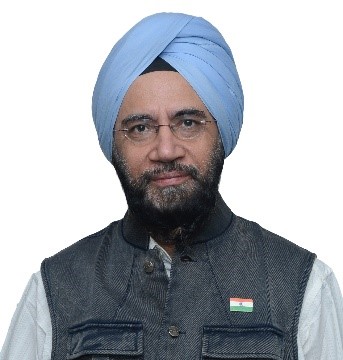Last Date for paper submission- Oct 16, 2022. Publication Opportunity 1- Journal of Emerging Markets Finance. Publication Opportunity 2- Journal of Behavioral and Experimental Finance.
Behavior of Securities Markets – Sighting of Black Swan
ABOUT THE CONFERENCE
SEBI and NISM are glad to invite academicians, researchers, students and other stakeholders to participate in the Second SEBI-NISM Research Conference on “Behavior of Securities Markets – Sighting of Black Swan”. The conference is to be held in the webinar mode during 25-26 February, 2021.
The goal of this conference is to continuously improve the research standards in securities markets, facilitate industry academia interaction and exchange of information and knowledge. The conference aims at providing a platform for every participant to share their unique perspectives, thoughts and knowledge.
This Conference is open for all the researchers, faculty members, market intermediaries in the areas of Finance across the globe.
Key Themes:
The conference themes include the following:
- Securities Market Response to Black Swan Events
- Impact of Technology on Economy and Markets during COVID-19
- Investor response to Black Swan Events
- Impact of Black Swan Events on Asset Classes and Market Structure
- Corporate Finance Response to COVID-19
- Market Dynamics
KEY DATES
- Dates for the Conference: February 25-26, 2021
- Last date for Submission of Abstract: October 31, 2020
- Last date for Submission of Final Paper: December 13, 2020
- Announcement of Acceptance of Paper for Presentation latest by: January 25, 2021
- Conference Registration Begins: February 15, 2021
- Last Date for Registration: February 23, 2021
CONTACT US
For any queries contact:
Mr. Ashutosh Kumar
Email Id: ssir@nism.ac.in
Mobile No. : 9326022370/7506581992
WhatsApp No. : 7506581992
Conference Co-coordinator
Dr. Pradiptarathi Panda
Assistant Professor, NISM
Email- pradiptarathi.panda@nism.ac.in
Conference Coordinator
Dr. Latha Chari
Associate Professor, NISM
Email- latha.chari@nism.ac.in
ABOUT SEBI
SEBI was given statutory powers on April 12, 1992 in accordance with the provisions of the SEBI Act, 1992. SEBI is the regulator of the Indian securities market. The Preamble of SEBI describes the basic functions of SEBI as “…to protect the interests of investors in securities and to promote the development of, and to regulate the securities market and for matters connected therewith or incidental thereto.”
For more details please visit www.sebi.gov.in.
ABOUT NISM
The National Institute of Securities Markets (NISM) is a public trust established in 2006 by SEBI. The institute carries out a wide range of capacity building activities at various levels aimed at enhancing the quality standards of and increase the participation in the securities markets. The institute’s six schools of excellence work towards creating a professionalized securities markets.
For more details please visit www.nism.ac.in.
-
Mr. Ajay Tyagi
Chairman, SEBI
-
| Name: |
Mr. Ajay Tyagi |
| Title: |
Chairman, SEBI |
Inaugural Session (February 25, 2021, 10:00 am – 11:00 am)
Mr. Ajay Tyagi assumed office as Chairman of Securities & Exchange Board of India (SEBI) with effect from March 1, 2017.
In a career spanning over 36 years, Mr. Tyagi, a former Indian Administrative Service (IAS) Officer, has held several responsible positions with distinction in the Central and State Governments before joining SEBI.
Mr. Tyagi served as an Additional Secretary in the Department of Economic Affairs, Ministry of Finance, and Government of India, handling diverse areas like Capital Markets, Investment, Infrastructure Financing, Financial Sector Reforms, Financial Stability Issues and Coins & Currency. Earlier, he served as a Joint Secretary in the Ministries of Environment & Forests and Petroleum & Natural Gas. He also worked as Chairman of Central Pollution Control Board and Secretary of the Petroleum and Natural Gas Regulatory Board.
In the Government of Himachal Pradesh, he served as Additional Chief Secretary and Principal Secretary in the Departments of Finance, Planning, Industries and Information Technology.
Mr. Tyagi did his graduation in Electrical Engineering from Delhi College of Engineering and post-graduation in Computer Science from Indian Institute of Technology, Kanpur. He has also done Masters in Public Administration from Harvard University.
-
Ms. Madhabi Puri Buch
Whole Time Member, SEBI
-
| Name: |
Ms. Madhabi Puri Buch |
| Title: |
Whole Time Member, SEBI |
Inaugural Session (February 25, 2021, 10:00 am – 11:00 am) & Transitioning from Bank to Market based Financing regime: Regulatory Challenges and Prospects (February 26, 2021, 09:00 am – 10:00 am)
Ms. Madhabi Puri Buch is a Whole Time Member, Securities and Exchange Board of India in Mumbai, looking after supervision of Mutual Funds and Alternate Investment Funds as well as the Market Surveillance Department in SEBI. In addition, she heads the Information Technology and Research Departments in the organization.
Prior to this assignment, Ms. Buch served as Consultant to the New Development Bank in Shanghai, China. Ms. Buch also served as the Head of the Singapore office of the Private Equity Firm, Greater Pacific Capital. She also served as the Managing Director and Chief Executive Officer at ICICI Securities Limited and as Executive Director, on the Board of ICICI bank.
Ms. Buch also served as a non-executive director on the Boards of various companies and ran a not-for-profit foundation.
Ms. Buch holds an M.B.A. from the Indian Institute of Management, Ahmedabad and is a Graduate in Mathematics from St. Stephen’s College, New Delhi.
-
Mr. Santosh Kumar Mohanty
Whole Time Member, SEBI & Director, NISM
-
| Name: |
Mr. Santosh Kumar Mohanty |
| Title: |
Whole Time Member, SEBI & Director, NISM |
Inaugural Session (February 25, 2021, 10:00 am – 11:00 am)
Mr. Santosh Kumar Mohanty is an IRS Officer of 1991 Batch and is presently posted as a Whole Time Member, Securities and Exchange Board of India in Mumbai since June 2018.
Prior to taking charge as Whole Time Member, Mr. Mohanty held the position of Executive Director, Securities and Exchange Board of India, on Deputation since September 2015.
As a Whole Time Member of SEBI, Mr. Mohanty was looking after the entire Secondary Market comprising Market Regulation Department and Commodity Derivative Market Regulation Department before taking up the responsibility of Corporate Finance Department dealing with Primary Markets. He also chaired the High Powered Committee on Cyber Security constituted by SEBI to spearhead the cyber security activities of the MIIs and was a Member of Technical Advisory Committee of SEBI. Mr. Mohanty also chaired a Working Group constituted by the Government of India for strengthening of regulation of warehousing and recommending norms to be adopted for warehousing of non-agricultural commodities.
Prior to joining SEBI on Deputation, Mr. Mohanty served as Director at the erstwhile Forward Markets Commission (FMC) where he was in-charge of the Market Policy and the Legal Affairs Division and played a critical role in the merger of FMC with SEBI. As an IRS officer he has served for more than 25 years in the Income Tax department at various cities of the country.
Mr. Mohanty has been acting as Director, NISM since August 2019.
-
Mr. Siddharth Tiwari
Chief Representative for Asia and Pacific, Bank for International Settlements
-
| Name: |
Mr. Siddharth Tiwari |
| Title: |
Chief Representative for Asia and Pacific, Bank for International Settlements |
February 25, 2021 – Technology Revolution: Rethinking Financial Market Infrastructure and Supervision (12:30 pm – 01:30 pm)
As Chief Representative since November 2018, Mr. Tiwari heads the Bank for International Settlements’ Office for Asia and the Pacific, based in Hong Kong.
For over 3 decades, he has been a thought leader, global policy maker and a member of senior management teams in large, complex, global financial institutions, including the IMF, and his work has spanned across 5 continents. At various phases during his career, he has been responsible for leading the strategy and design of global financial architecture; directing policy and lending operations; managing a large international Board of Directors; implementing deep institutional restructuring; heading multi-billion-dollar investment committees; managing billion-dollar budgets; and serving a term in a senior academic appointment. With substantial experience in Asia, Mr. Tiwari has led engagement between and within international bodies, public sector, think tanks, philanthropies, civil society, financial markets, and academia, guiding institutions and designing public policy to adapt to changing global needs.
Mr. Tiwari holds degrees in Economics from the University of Chicago, the London School of Economics and the University of Delhi.
-
Mr. Sharad Sharma
Co-founder, iSPIRT Foundation
-
| Name: |
Mr. Sharad Sharma |
| Title: |
Co-founder, iSPIRT Foundation |
February 25, 2021 – Technology Revolution: Rethinking Financial Market Infrastructure and Supervision (12:30 pm – 01:30 pm)
Sharad’s mantra is to lead ecosystems and companies through orbit change. He has three decades of experience in the Internet, Enterprise Software, Digital Finance and Digital Health sectors and is a prominent voice in India’s technology ecosystem. Sharad is a passionate evangelist of the software product ecosystem in India. He co-founded iSPIRT Foundation, a non-profit technology think tank devoted to making India a product nation. Earlier, he Chaired NASSCOM Product Forum in its formative years and was a member of the NASSCOM Executive Council from 2009-13.
Sharad co-founded Teltier Technologies Inc., a wireless infrastructure start-up now part of CISCO, and is an active technology angel investor with over two dozen investments. He was also instrumental in the success of India’s first IP focussed fund, India Innovation Fund. Sharad has held several senior R&D executive positions with leading technology companies, including Yahoo, VERITAS Software, Symantec, Lucent Technologies, and AT&T. Zinnov gave him the R&D Visionary Award in 2008 for his work on creating a strong MNC R&D footprint in India. Sharad is a member of SEBI’s Financial and Regulatory Technology Committee. He has also served on RBI’s UK Sinha MSME Committee and National Digital Payments Committee. Sharad got interested in kernel software development while doing his Electrical Engineering at Delhi College of Engineering. He started India’s first Student Minicomputer Club in 1984 as served as the Chairperson of the IEEE Student Chapter.
-
Dr. S. P. Kothari
Former Chief Economist and Director DERA, SEC, USA
-
| Name: |
Dr. S. P. Kothari |
| Title: |
Former Chief Economist and Director DERA, SEC, USA |
February 25, 2021 – Black Swan Event and Agenda for Capital Reforms (05:45 pm – 06:45 pm)
Dr. S. P. Kothari is Gordon Y Billard Professor of Accounting and Finance at MIT’s Sloan School of Management. Recently, he served as the Chief Economist and Director of the Division of Economic and Risk Analysis (DERA) at the US Securities and Exchange Commission from March 2019 to January 2021. In this role, he oversaw a team of approximately 160 economists, data scientists, and other professionals who provide economic analysis of securities regulation, international prudential and regulatory analysis and data analytics all in support of the SEC’s mission.
Previously, Dr. Kothari spent nearly two decades at MIT, both as a professor and as deputy dean of MIT Sloan School of Management. His wide-ranging research interests include financial reporting, valuation, asset allocation, international accounting practices, executive compensation, investment performance, and derivatives.
Dr. Kothari has served as the Co-Chair of the Board of Governors Asia School of Business, Kuala Lumpur, faculty director of the MIT-India Program, and editor of the academic publication Journal of Accounting & Economics. In 2008-09, he served as global head of equity research for Barclays Global Investors, where he was responsible for research supporting the firm’s active equity strategies for a portfolio in excess of $100 billion and for managing a team of approximately 50 PhDs based around the world. From 2015-19, Dr. Kothari served as a director of Bombay Stock Exchange (BSE).
Dr. Kothari is a recipient of India’s Padmashri award in 2020 and an Honorary Doctorate from London Business School in 2019.
Dr. Kothari received his B.S. in Engineering from the Birla Institute of Technology & Science and his MBA (PGDM) from the Indian Institute of Management. Dr. Kothari earned his PhD from the University of Iowa.
-
Mr. Nehal Vora
MD and CEO of CDSL, India
-
| Name: |
Mr. Nehal Vora |
| Title: |
MD and CEO of CDSL, India |
February 25, 2021 – Black Swan Event and Agenda for Capital Reforms (05:45 pm – 06:45 pm)
Mr. Nehal Vora is the Managing Director & Chief Executive Officer of Central Depository Services (India) Ltd. (CDSL) since September 24, 2019. CDSL under his leadership, has emerged as the leading Depository of India with over 27 Million beneficiary accounts. CDSL is Globally the second largest Depository and the first and the only depository to launch have a Branch at the International Financial Services Centre (IFSC) at the GIFT City, Gandhinagar, India. He focusses on building Robust franchise by implementing strong systems and processes enabling effective governance.
He is also a Director on the Board of AIC-NMIMS Incubation Centre, launched by NMIMS – a premier B school in India, in collaboration with NITI Aayog, Government of India.
Mr. Vora has over 2 decades of experience across diverse segments in Capital Markets. In his earlier role as the Chief Regulatory Officer of BSE Limited and the member of the Executive Leadership Team, he drove regulatory excellence through membership compliance, surveillance, inspection, investigation, regulatory communication, investor services, listing compliance and regulatory legal teams.
He began his career with Securities and Exchange Board of India (SEBI) in 1996, where, he managed various functions including the Derivatives and New Products Department, covering policy, product and process innovation in areas of derivatives. He also implemented the T+2 rolling settlement and the system of Straight through Processing for the Institutional trades for the Indian Securities Markets.
Mr. Vora has also headed the Broking and Investment Banking Compliance at a leading brokerage house- DSP Merrill Lynch Ltd, as the Director, Law and Compliance.
He has been felicitated with Distinguished awards including NetApp Innovation Award 2019 for Social Media Parsing (using Artificial Intelligence), Compliance Champion award, IDC Digital Transformation Awards, Best New Product in Asia for Market Surveillance, OGC Living the Mission Award amongst many others and latest being recognised as the Distinguished Alumnus. He is a guest speaker at various international forums, conferences and is also a lecturer at the National Institute of Securities Markets (NISM).
Mr. Vora holds a Commerce degree and a Master of Management Studies degree in Finance.
-
Mr. Ashley Ian Alder SBS, JP
CEO, Securities and Futures Commission, Hong Kong, Chair of Board, International Organization of Securities Commissions
-
| Name: |
Mr. Ashley Ian Alder SBS, JP |
| Title: |
CEO, Securities and Futures Commission, Hong Kong, Chair of Board, International Organization of Securities Commissions |
February 26, 2021 – Transitioning from Bank to Market Based Financing Regime: Regulatory challenges and Prospects (09:00 am – 10:00 am)
Mr. Ashley is the Chief Executive Officer of the Securities and Futures Commission (SFC) of Hong Kong. He was first appointed in October 2011. In May 2016, Mr. Ashley was elected as Chair of the Board of the International Organization of Securities Commissions (IOSCO), and was re-elected for a further two-year term in June 2020. Mr. Ashley was previously Chair of the IOSCO Asia-Pacific Regional Committee and Vice Chair of the IOSCO Board. Mr. Ashley has represented IOSCO as a member of the Financial Stability Board Steering Committee and Plenary since his election as IOSCO Board Chair.
Mr. Ashley started his career as a lawyer in London in 1984. He moved to Hong Kong in 1989 with the international law firm Herbert Smith, practicing corporate and business law. He was Executive Director of Corporate Finance at the SFC from 2001 to 2004, before returning to Herbert Smith, where he became head of the firm’s Asia Region.
-
Dr. Suraj Srinivasan
Philip J Stomberg Professor, Harvard Business School
-
| Name: |
Dr. Suraj Srinivasan |
| Title: |
Philip J Stomberg Professor, Harvard Business School |
February 26, 2021 – Corporate Governance and Financial Resilience: Lessons from Shock Events (05:00 pm – 06:00 pm)
Suraj Srinivasan is the Philip J. Stomberg Professor and department chair of the Accounting and Management area at Harvard Business School. He is an expert in corporate governance and studies the role of capital market institutions and the board of directors in promoting effective governance of organizations. He is the chair of several board of directors programs at HBS and serves on the board of directors of Harvard Publishing Company. Prior to joining HBS in 2008, Professor Srinivasan was on the faculty at the University of Chicago Graduate School of Business. His research has been published in leading academic journals and he is frequently cited in the media on corporate governance issues. He currently serves as the editor and on the editorial boards of leading accounting and management journals.
Professor Srinivasan earned a bachelor’s degree with honors in electrical and electronics engineering and a master’s degree in physics with honors from Birla Institute of Technology and Sciences in India prior to earning an MBA from the Indian Institute of Management Calcutta. He also received a doctorate degree in business.
-
Mr. Amarjeet Singh
Executive Director, SEBI
-
| Name: |
Mr. Amarjeet Singh |
| Title: |
Executive Director, SEBI |
February 26, 2021 – Corporate Governance and Financial Resilience: Lessons from Shock Events (05:00 pm – 06:00 pm) & Valedictory Session (February 26, 2021, 06:00 pm – 06:15 pm)
Mr. Amarjeet Singh, working with SEBI for the last 25 years has extensive experience in regulation and supervision of securities markets. He is presently working as Executive Director in charge of Corporate Finance Department dealing with Primary Market reforms, Issuance and listing of securities, Corporate governance, Corporate restructuring, Delisting etc. He also heads the Department of Economic Policy and Analysis at SEBI. Earlier between 2010 and 2017, he was heading the front office of Chairman, SEBI as his Executive Assistant and also the Office of International affairs. In his earlier stint, he headed the Northern Regional Office of SEBI at New Delhi from 2005 to 2009.
Mr. Singh has been involved in various international regulatory initiatives. He has acted as Sherpa for SEBI’s representation on the Board of International Organization of Securities Commissions (IOSCO) for 7 years. He chaired the Assessment Committee of IOSCO during 2016-18 and steered an assessment program for conducting thematic assessments at the global level.
He represents SEBI as a part time member on the board of National Financial Reporting Authority and on the board of Governors of the Indian Institute of Corporate Affairs. During 2017-19, he was on the Board of National Institute of Securities Markets (NISM), an institute founded by SEBI.
He has represented SEBI on numerous Committees set up by Reserve Bank of India and Government of India. In the recent years, his nomination on such committees include Member of Core Investment Committee set up by RBI in 2019 post ILFS fiasco, Member of Committee set up by Ministry of Corporate Affairs on Corporate Social Responsibility (2019) and Insolvency Law Committee (2018).
Apart from an MBA, he holds a Master’s degree in Economic Policy Management from Columbia University, NY, USA. He is a Member of the India Advisory Board, Newcastle University Business School, UK. He is a recipient of Rotary Foundation Educational Award, 2000 for promoting leadership development and international understanding by Rotary International, USA.
-
Mr. Sunil Jayawant Kadam
Registrar, NISM
-
| Name: |
Mr. Sunil Jayawant Kadam |
| Title: |
Registrar, NISM |
Vote of Thanks (February 26, 2021, 06:15 pm – 06:30 pm)
Mr. Sunil Kadam is the Registrar of National Institute of Securities Markets (NISM), an educational initiative of the Securities and Exchange Board of India (SEBI). Mr. Kadam holds a degree of Master of Business Administration (MBA) from University of Pune. Prior to taking over as Registrar of NISM, Mr. Kadam was Regional Director of Northern Regional Office of SEBI. Mr. Kadam has joined SEBI in 1996 and during his tenure in SEBI he has worked in various departments in SEBI and handled the work relating to administration and inspection of Market Infrastructure Institutions (MIIs) and SEBI registered intermediaries, surveillance and investigations, corporation finance, forensic accounting, corporate governance, Business Responsibility Reports, Indian Depository Receipts (IDRs), E-voting, search and seizure, treasury and accounts, enquiry and adjudications, litigations, etc.
Mr. Kadam was also a member of SEBI Committee on Disclosures and Accounting Standards (SCODA) and Auditing & Assurance Standards Board of The Institute of Chartered Accountants of India (ICAI). He has also represented SEBI in Asian Roundtable on Corporate Governance meetings organized by the Organization for Economic Co- operation and Development (OECD) and was also part of OECD report on “Related Party Transactions and Minority Shareholder Protection”.
Academicians, researchers, students and other stakeholders are invited to submit abstracts related to the specified themes only.
Author/co-author can submit only one abstract (not less than 300 words) that provides insights into the potential findings, data source and details of methodology of the study. The submitted work should not have been published elsewhere and should not be intended to be published elsewhere during the review period. Abstracts as per the above guidelines are to be submitted to conference@nism.ac.in
Final papers are to be submitted on or before the specified dates. Final paper submission is to be done through Easychair .
The guidelines for the paper submission are –
- There will be only paper by one author/co-author.
- Only empirical papers will be considered for this conference.
- Papers shall not be longer than 10,000 words excluding bibliography and references.
- Papers shall be based on data sourced from authentic sources only. The source of data used/referred in the paper should be clearly mentioned.
- Papers needs to be submitted in pdf/word without the details of the author along with a maximum of 5 key words along with Journal of Economic Literature (JEL) codes.
- The paper should be unpublished, original and empirical. The font should be in Times New Roman with 12 font size and single spaced.
- The plagiarism of the paper should not exceed 25%. If it exceeds will not be considered for the review process.
- All papers will be blind reviewed to ensure an adequate standard, proposed subject of the submitted abstract has been followed, length of paper.
- The author’s details including name, title, current position along with the name of the organisation, and contact details needs to be mentioned only in the title page. The authors need to submit two files. One is the title page and another is the main paper.
- No changes will be allowed in the paper title, paper and authorship after submission.
- Footnotes can be used but end notes need to be avoided.
- Authors will be fully responsible for the accuracy of the data used in the manuscripts. Due reference needs to be given in the paper for the same.
- Bibliographical references need to be cited using the American Psychological Association (APA) style.
- All tables need to be numbered in Arabic numerals and should always be cited in the text with consecutive numbers. Each table should contain a ‘’Title of the Table’’. Footnotes of the table should be in subscript lowercase letters and needs to be placed below the table body. The table font should be 10, times new roman and it should be properly aligned.
- All figures need to be numbered and titled in chronological order. The figures should not be blurred.
- Paper layout should be One-column Portrait.
- Any violation of the rules given above will cause for the rejection of the paper.
Bibliographic References:
- References should include (a) Author’s surname, initials as it appears on the cited works, (b) Year of publication, (c) “Title of the paper”, (d) Name of the Journal, (e) Volume number, (f) (Issue number), and (g) Page references.
- References must appear at the end of the manuscript and not as footnotes on each page.
- Each source cited in the paper must appear in the reference list; likewise, each entry in the reference list must be cited in the text portion of the paper.
- Reference list entries should be alphabetized by the last name of the first author of each work.
- Authors’ names need to be inverted (last name first); give the last name and initials for all authors of a particular work for up to and including seven authors.
- All major words in journal titles needs to be capitalize. When referring to books, chapters, articles, or webpages, capitalize only the first letter of the first word of a title and subtitle.
- An example of bibliographic reference is given below-
Sims, C. A., Stock, J. H., and Watson, M. (1990), Inference in Linear Time Series Models with Some Unit Roots, Econometrica58, 113–144.
Selection of Papers:
- Papers submitted on or before the timeline will only be considered.
- Decision of Selection Committee on acceptance/rejection of the paper will be final.
- A lump sum amount of ₹ 5,000 will be awarded per selected paper to the author (to the first author only, if the paper is co-authored).
- The conference will offer the Best Paper Award to three best papers (first, second and third) and will be awarded ₹ 30,000, ₹ 25,000 and ₹ 20,000 respectively, which will be announced at valedictory session.
Call for Papers Themes:
The call for papers themes includes the following:
- Securities Market Response to Black Swan Events
- Corporate Finance Response to COVID-19;
- Regulatory Response to Black Swan Events;
- Impact of Pandemic on Corporate Governance and Disclosure Standards;
- Impact of Technology on Economy and Markets during COVID-19;
- Any Other Topic Related to Conference Theme.
Last Date for paper submission- Oct 16, 2022. Publication Opportunity 1- Journal of Emerging Markets Finance. Publication Opportunity 2- Journal of Behavioral and Experimental Finance.
REGISTRATION
Key Dates:
- Dates for the Conference: February 25-26, 2021
- Last date for Submission of Abstract: October 31, 2020
- Last date for Submission of Final Paper: December 13, 2020
- Announcement of Acceptance of Paper for Presentation latest by: January 25, 2021
- Conference Registration Begins: February 15, 2021
- Last Date for Registration: February 23, 2021
How to Register?
All interested participants including paper presenters will register through registration link. For Registration,click here
Registered participants should attend through go to webinar and meet attendance requirements for certificate purposes.
Conference can also be accessed through you tube channel.
| Date |
Youtube Link |
| 25/02/2021 |
https://www.youtube.com/watch?v=gV6InmU7FGo |
| 26/02/2021 |
https://www.youtube.com/watch?v=g0m1ZBDyL7o |
How to Register
User ID and Password is only provided to check the registration & participants details. To check, Click Here
Note: *Registration fees: Nil
For registration contact:
Ashutosh Kumar,
Email id: ssir@nism.ac.in,
Mobile no.-9326022370/7506581992.













